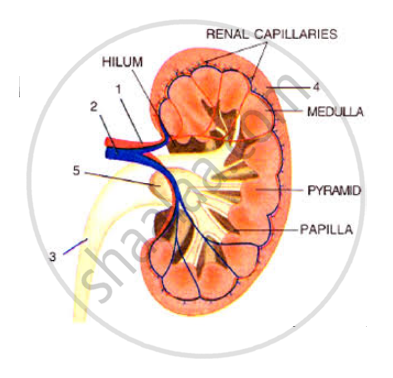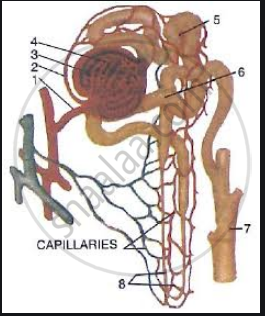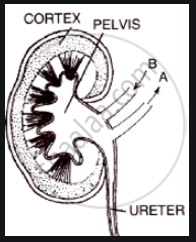Advertisements
Advertisements
प्रश्न
Explain in your own words with suitable examples.
How does excretion occur in human beings?
उत्तर
The human excretory system includes the kidneys, along with the ureters, bladder, and urethra. Urine is produced by the kidneys by separating waste materials from the blood and discarding excess and unnecessary substances.
Process of urine preparation:
- In the kidneys, urine is produced after the filtration process of blood through the nephrons.
- In Bowman's capsule of the nephron, the glomerulus is a plexus of blood cells. Urea produced by the liver comes into the blood. When this urea-rich blood reaches the glomerulus, it is filtered by the blood cells of the glomerulus.
- The selective membrane of Bowman's capsule allows water molecules and small molecules of other substances to pass through the pore.
- The fluid present in Bowman's capsule later reaches the nephron tubule. Water and appropriate molecules are mixed back into the blood in different parts of the nephron tubule.
- Urine is prepared from all the constituent substances unnecessary to the body.
- The produced urine is stored in the bladder through the ureters.
- There is voluntary control over passing urine, hence when desired, it is expelled through the urinary tract.
APPEARS IN
संबंधित प्रश्न
Explain the term haemodialysis.
The kidneys in human beings are a part of the system for ______.
Name the Following
The organ which produces urea.
Give biological reasons for the following statements: There is frequent urination in winter than in summer
The Biological/technical term for The removal of nitrogenous wastes from the body
Name the basic filtration unit present in the kidney.
Name a waste gas released by the plants only during the night time.
Name the two parts of a plant through which its gaseous waste products are released into the air.
Tick the most appropriate answer.
Quinine is used in the treatment of
Choose the correct answer:
A condition of failure of kidney to form urea is called ____________
Look at the figure given below. It is a section of human kidney as seen from the front.

Which area/part (give its name and number given on the diagram) which contains the following:
(i) Malpighian capsule
(ii) The pyramids
(iii) Freshly collected urine
The following diagram represents a mammalian kidney tubule (nephron) and its blood supply.

Parts indicated by the guidelines 1to 8 are as follows:
1. Afferent arteriole from renal artery
2. Efferent arteriole
3. Bowman's capsule
4. Glomerulus
5. Proximal convoluted tubule with blood capillaries
6. Distal convoluted tubule with blood capillaries
7. Collecting tubule
8. U-shaped loop of Henle
Study the diagram and answer the question that follow:
Which structure (normally) contains the lowest concentration of glucose?
Given below is a highly simplified diagram of the human kidney cut open longitudinally. Answer the question that follow:
Name the functional units of the kidneys.

Answer the following question:
Explain the human excretory system with the help of a suitable diagram.
Describe in brief how urine is produced in the human body.
Explain the functioning of kidney.
Give Technical Terms
The hormone that helps increase the reabsorption of water from the kidney tubules.
Choose the correct option.
Visceral layer : Podocytes :: PCT : ________.
Plants use completely different process for excretion as compared to animals. Which one of the following processes is NOT followed by plants for excretion?
